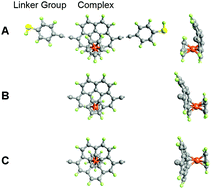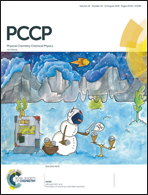A computational study on a multimode spin conductance switching by coordination isomerization in organometallic single-molecule junctions
Abstract
Single-molecule junctions provide the additional flexibility of tuning the on/off conductance states through molecular design. Here, we focus on a family of organometallic complexes with a conjugated curved buckybowl as the ligand. Using first-principles calculations, a multi-mode reversible spin switching based on the CpFe·corannulene complex is predicted by the temperature control of the CpFe+ coordination position in corannulene. The different spin conductance states for three coordinated modes are ascribed to the different electronic spin states of the organometallic complex due to crystal field effects. The predicted relative stabilities of isomers and the energy barriers of isomerization reactions can ensure that the conversion among the three isomers can occur quickly and, at a specific temperature, a dominant isomer has a higher proportion than the other two isomers. This provides a new framework for understanding transport in organometallic complexes with localized d states. This presents an exciting opportunity for exploiting junctions involving molecular spin switching.



 Please wait while we load your content...
Please wait while we load your content...